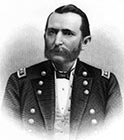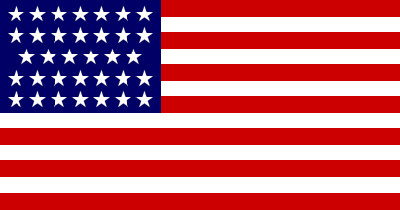Official List of Killed and Wounded at the Battle of Bear River

Great Salt Lake City, Utah. February 9th, 1863
It is much easier to conceive than to execute, and it is a much simpler business to ask than to grant. To have sent you an imperfect list of the wounded would have been only to add pain to anxiety. Not a friend, relative or family interested in the California Volunteers would have been satisfied with hearing only that "he was wounded. It is the natural inquiry How much?
Slightly,
Dangerously,
Mortally,
and Where?
I conceived, therefore, that a full report alone would satisfy the citizens of California, and here it is though telegraphed to, wrote to, and visited the camp to obtain it, but delay was unavoidable. Colonel Connor freely favored my correspondent is indebted for many courtesies– at once set about the work.

The list is painfully interesting. The character of the wounds show, more forcibly than could our feeble pen exhibit, the terrible contest that must have raged the first four hours of day on the memorable 29th of January. Nothing but the daring, heroic, indomitable will of the volunteers could have stood up against the well directed fire of the Indian. Protected in his lurking place, where no eye could behold his presence, he steadily aimed and sent the messenger of death with almost murderous precision at every touch of the trigger. The more serviceable also appears his carefully prepared list, as the sad fact is too visible, that since the battle more than one-half the number that there fell have died from their wounds. How many more may be added to the list is beyond the ken of mortals; but if hope can be nourished, and groundless fears be dispelled, by certified facts, the list will not have been published in vain:
Killed and Wounded
Second Cavalry
Company A
Killed– James W. Baldwin, private, through the chest.Killed– George German, private, above the heart. Wounded–- John Welch, private, arrow in each lung; dangerously.
John Wm. Wall, private, shot in the right arm; dangerously.William H. Lake, private, shot in the mouth; badly.- William Jay, private, index finger shot off; slightly.
- James Montgomery, private, right lung; dangerously.
Company H
Killed– Charles Hallowell, private, center of chest.Killed– John K. Briggs, private, through the chest. Wounded–- B.C. Hutchison, private, right arm; badly.
- F. Farley, private, left eye; dangerously.
- J. Logue, private, right elbow; badly.
-
Michael O'Brien, private, left lung; dangerously. Patrick Frawley, corporal, right shoulder and spine; dangerously.- P. Schaub, private, left lung; dangerously.
- J. Cloves, private, right shoulder; slightly.
- J. Franlyn, private, right hip and neck; dangerously.
James Cantillon, sergant, left lung; dangerously.- T. Ridge, private, right arm; slightly.
Company K
Killed– Christian Smith, bugler, center of chest, right to left.Killed– Shelbourne Reed, private, through the head.Killed– Adolphus Rowe, private, through both lungs.Killed– Lewis Anderson, private, through the heart.Killed– Henry W. Trempf, private, through both lungs. Wounded–- M. Elleg, private, right shoulder; badly.
- A. McCoy, private, navel; slightly.
- Benjamin Landes, corporal, right shoulder; dangerously.
- Robert Hargrave, private, right elbow; badly.
- S. Bush, private, left ankle; badly.
- W.B. Welton, private, right thigh; badly.
William M. Slocum, private, right lung; dangerously.- John Lee, private, right arm and hip; badly.
- A.M. Parker, private, left arm; badly.
- __ Brady, private, nose and face; dangerously.
- N. Kinsley, private, right side and arm dangerously.
- J.S. Longley, private, neck; badly.
- John Daley, private, left breast and shoulder; dangerously.
- __ Kelly, private, abdomen; slightly.
Company M
Killed– George C. Cox, private, through both lungs.Killed– George W. Hoten, private, through the heart.Killed– Asa F. Howard, wagoner, through the heart. Wounded–Anthony Stevens, sergant, chest and shoulder; dangerously.- P. Humbert, private, top of head; slightly.
- __ Heffner, private, right arm; slightly
- John Stevens, private, top of head; slightly.
- J. Leggitt, private, left shoulder; dangerously.
- T. Barcafer, private, right shoulder; dangerously.
- R. Miller, private, right shoulder; dangerously.
- E.C. Chase, private, right shoulder; badly.
- M. Forbes, private, hand and arm; badly.
- L.W. Hughes, corporal, nose and right side; badly.
- L.D. Hughes, private, right leg; badly.
William Davis, private, right lung.- W.H. Hood, private, left hand and groin; badly.
- L. Robins, sergeant, right side; badly.
Third Infantery
Company K
Killed– John E. Baker, private, through heart and stomach.Killed– Samuel J.W. Thomas, private, through the chest. Wounded–- A. Austin, sergant, right eye; danerously.
- E.C. Hoyt, sergant, left lung; dangerously.
- J. Hensley, private, right leg; badly.
- T.B. Walker, private, left side; badly.
Officers Wounded
- Major P.A. Gallagher, Third Infantry, left arm; badly.
- Captain Daniel McLean, Company H, Second Cavalry, left thigh and right arm; dangerously.
Lieutanant Darwin Chase, Company K, Second Cavalry, left lung; dangerously.- Lieutanant D.J. Berry. Company A, Second Cavalry, right shoulder; dangerously.

The following named officers and men are in the hospital with frosted feet:
Second Cavalry:
Company A.– Corporals Spreggle and Duvall; Privates G.R. Swan, John D. Marker, S. Shomadan, R.M. McNulty, __ McCue.
Company H.– Sergeant J.W. Kilgore; Privates George Fisher, Stula, A. Langraf, John Allmen, Braley, T.R. Gaston, A.F. Lockhard, H. Smith, J.M. Norton, W.M. Stier, W.M. Maber, W.W. Goodell, W.M. Walton, E.J. Casneau, H.A. McDonald.
Company K.– Sergeant William L. Beach; Corporals W.M. White and Hunt; Privates J. Lincoln, Burns, Daly, S. Ansley, M. Atmore, F.W. Becker, W. Chapman, J.J. Hertle, S.L. Caldwell, C. Howe, J. Hill, G. Johnson, A. Mitchell, J. McKnow, A.S. Palmer, C. Wilson, Barton.
Company M.– Sergeant John Cullen; Corporals A.P. Hewett, W.M. Steel; Privates W.M. Collins, A.P. Case, J. Dyer, John McGonagal, D. Griffin.
Third Infantry:
Company K.– Sergeants C.J. Herron. C.F. Williams; Corporals J.H. Zollman, J. Wingate, W.A. Bennett; Privates W. St. John, A. Ramsdell, J.E. Epperson, A.F.H. Randall, W.H. Farnham, J. Boarland, G.W. Ticknor, A. Rensho, B.B. Bigelow, J. Anderson, S. Urquhart, F.L. Borass, F.W. Branch, Bailey, William Carlton, D. Donahue, C.H. Godbold, J. Haywood, C.W. Heath, J. Manning, W.G. Way, J. German.
| Regiment | Killed | Wounded | Frosted Feet | Total |
|---|---|---|---|---|
| Second Cavalry, Company A | 2 | 5 | 7 | 14 |
| Second Cavalry, Company H | 2 | 11 | 16 | 29 |
| Second Cavalry, Company K | 5 | 14 | 21 | 40 |
| Second Cavalry, Company M | 3 | 15 | 8 | 26 |
| Third Infanttry, Company K | 2 | 4 | 27 | 33 |
| Totals | 14 | 49 | 79 | 142 |
Died Second Cavalry
- Private William Davis, Company M, February 2nd, at Ogden.
- Lientenant Darwin Chase, Company K, February 4th, at Farmington.
- Sergeant James Cantillon, Company H, February 5th, at Camp Douglas.
- Private William M. Slocum, Company K, February 5th, at Camp Douglas.
- Sergeant Anthony Stevens, Company M, February 6th, at Camp Douglas.
- Private Michael O'Brien, Company H, February 6th, at Camp Douglas.
- Corporal Patrick Frawley, Company H, February 8th, at Camp Douglas.
- Private John Wm. Wall, Company A, February 8th, at Camp Douglas.
-
William H. Lake, Company A, March 24th, at Camp Douglas.*
However well we may draw upon philosophy, and challenge manhood within us, there is in spite of everything, a cold sadness in the performance of the last homage of the living to the dead. I was at camp from early morn on Friday till late in the evening– in the interest of the Union; but, had it been otherwise, I certainly would have attended the interment of the volunteers. The day was cold and raw; notwithstanding, there was a large number of persons from the city. There was probably a score of carriages, many equestrians and quite a concourse of people on foot. Had it been generally known, there would, no doubt of it, have been many more. As it was, I expect it was pleasing to those who take interest in the entente cordiale to witness the very respectful demeanor of those present.

Up to one p.m., the sixteen coffins lay side by side in the Quartermaster's storeroom, where the dead were visited by their surviving command formed in procession and escorted the bodies to the military graveyard, where Parson Anderson officiated in the burial service. Three volleys were fired over the bodies as they were laid in their graves, and the last sole rites were ended. The band, that before led the measured, solemn step of the procession to the funeral dirge and Dead March, now moved away gaily, reviving the thoughtful, and recalling to the duties and obligations of life those who had not yet finished their page of history.
On Friday the remains of Lieutenant (Darwin J.) Chase were consigned to their resting place by the brethren of the Masonic fraternity attached to the command, together with a few from the city. The deceased was a Royal Arch Mason, but the small number of that trade in attendance rendered the adoption of the Master Mason's burial service necessary. For the solicitation of the brethren, Sir Knight Frank Fuller, Secretary of the Territory, officiated as W.M., and Colonel Evans, of the Second Cavalry, as Marshal. Chief Justice Kinney and United States Marshal Gibbs walked in the procession, which consisted together of some twenty members. The services at the grave were of a highly impressive character and were witnessed by nearly the whole command, together with numerous citizens. At the close of the solemnities, the fraternity changed their position, while a dirge was performed by the band, and gave place to a detail of forty-eight soldiers, who fired three volleys over the grave. The procession then returned to camp in reversed order.1
Special Correspondent for The Daily Alta California.
Notes…
William H. Lake